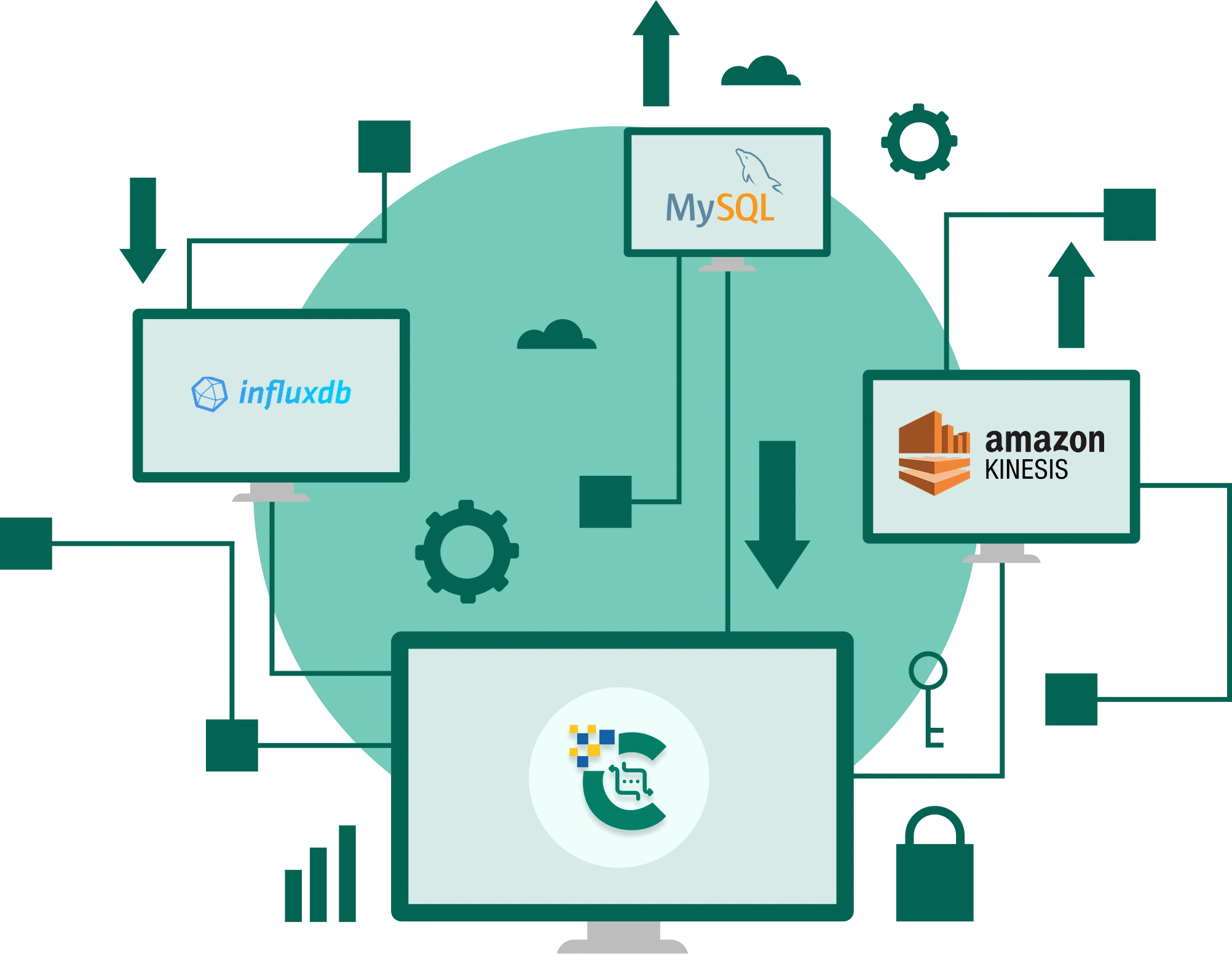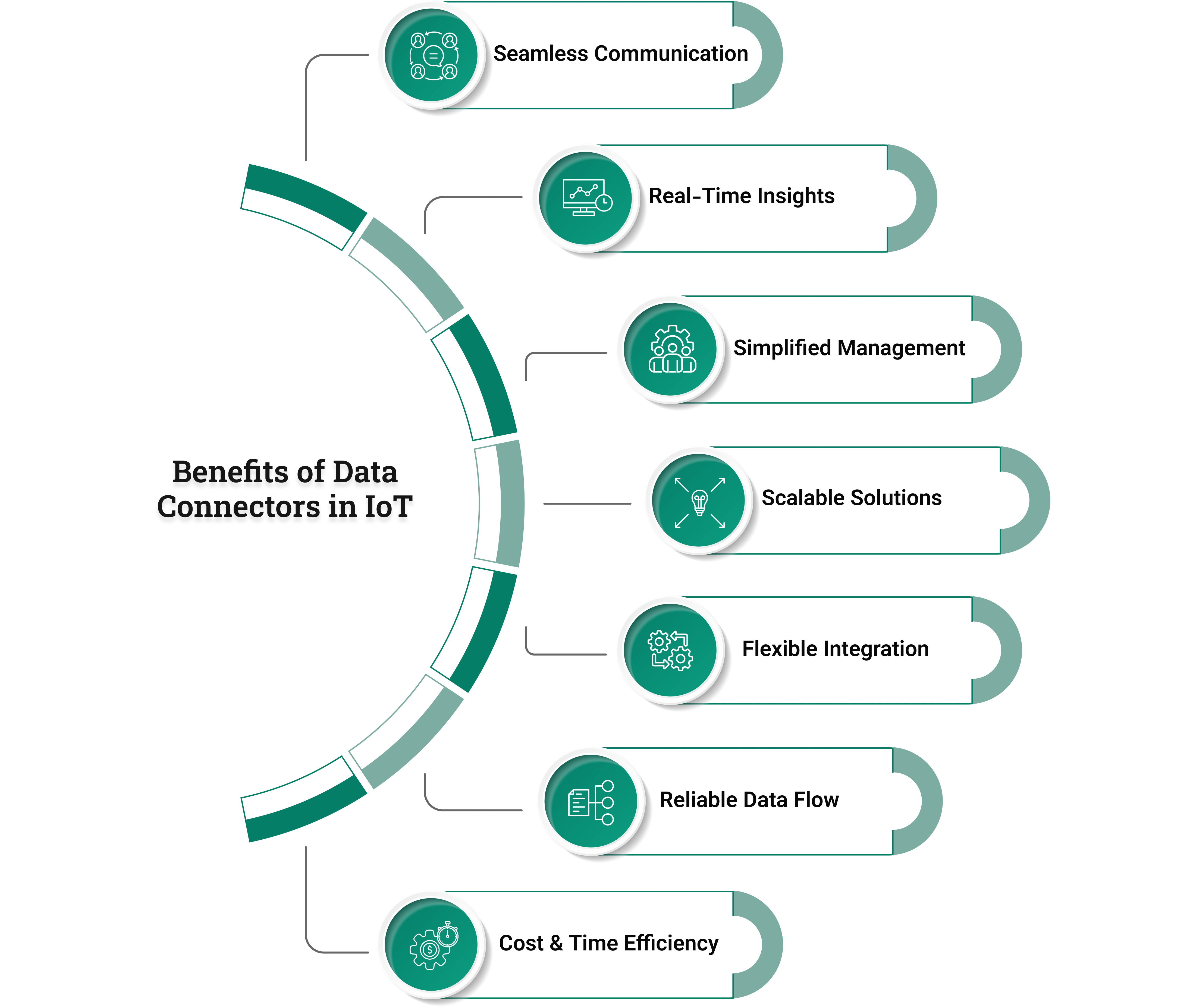How data connectors enhance IoT ecosystems?
Following are some of the ways in which data connectors contribute to enhancing our IoT ecosystems:
In today’s data-driven era, the Internet of Things (IoT) has emerged as a driving force for innovation across industries. With billions of connected devices generating immense volumes of data every second, businesses face the critical challenge of managing and leveraging this information effectively. IoT ecosystems are typically spread across numerous platforms, databases, and services, creating significant obstacles to ensuring seamless data flow, real-time insights, and compatibility with existing infrastructures. Overcoming these barriers requires solutions capable of bridging the gap between IoT devices and the diverse data systems businesses depend on.
This is where data connectors become invaluable. They streamline the task of linking and integrating various data sources, enabling devices to interact seamlessly with databases, cloud environments, and analytics tools. By utilizing the right data connectors, IoT systems can achieve higher efficiency, facilitate real-time decision-making, and scale effortlessly without the limitations of data silos or complex integration challenges. Our MQTT broker’s advanced data connector support empowers businesses to unlock the potential of their IoT solutions by enabling reliable, secure, and efficient data exchange between devices and external systems.

Data connectors within an MQTT broker act as a vital bridge, enabling the broker to establish direct communication with a wide array of external databases, data platforms, and services. These connectors eliminate the complexities associated with custom integrations, significantly reducing latency while ensuring uninterrupted and seamless data flow between systems. This functionality operates independently of the backend architecture or data storage solutions being utilized, offering unparalleled flexibility. By incorporating these connectors, our MQTT broker transcends its traditional role as a messaging platform to become a comprehensive solution for integrating, managing, and extracting actionable insights from diverse data sources.
Following are some of the ways in which data connectors contribute to enhancing our IoT ecosystems:

The rise of IoT has led to a massive surge in data generation, often stored across multiple silos within various platforms and systems. Managing this data effectively and ensuring its seamless movement across systems—whether it involves storing sensor data in a database, delivering real-time updates to a dashboard, or integrating data into machine learning models for advanced analytics—is essential for achieving efficient IoT operations. The ability to transfer data smoothly across these systems is a cornerstone of unlocking the full potential of IoT. This is where data connectors prove indispensable. They simplify the otherwise complex process of integrating multiple systems, enabling the MQTT broker to seamlessly interact with diverse backend systems and facilitate efficient data communication By bridging gaps between silos and ensuring reliable data flow, data connectors play a pivotal role in driving the success of IoT ecosystems.
Instant access to data insights is crucial for deeper analysis and for enabling data-driven decision-making, which plays a vital role in optimizing business processes. For organizations relying on real-time insights, the capability to seamlessly integrate IoT data with third-party platforms becomes indispensable. These platforms empower businesses to collect, visualize, and analyze data in real time , delivering actionable insights instantly. Establishing a direct connection between the MQTT server and platforms such as Kafka, Amazon Kinesis, and others not only enables instant data-driven decision-making but also facilitates predictive analytics. Moreover, it empowers businesses to respond swiftly to dynamic conditions within the IoT environment, ensuring operational efficiency and enhanced decision-making capabilities.
Data integrity holds immense importance in IoT applications , particularly in scenarios involving time-sensitive operations such as industrial automation, healthcare systems, or transportation networks. Ensuring that data is transferred reliably and consistently between various systems without any loss is a fundamental requirement for the success of these applications. This is where data connectors play a pivotal role, facilitating seamless and secure data transfer while maintaining its integrity throughout the process. Many connectors, such as MySQL, MongoDB, and Postgres, not only enable real-time data handling but also provide the capability to store information for extended periods. This long-term storage capability is invaluable for businesses, allowing them to preserve data accuracy over time while ensuring it remains readily accessible for detailed analysis, comprehensive reporting, and strategic decision-making. By leveraging these robust data connectors, organizations can achieve greater operational efficiency and data reliability, which are essential for driving innovation and maintaining a competitive edge in today’s IoT-driven landscape.

As IoT ecosystems grow, the volume of data generated by connected devices increases exponentially, creating both opportunities and challenges. Data connectors are essential for managing this growth by ensuring seamless data flow, even as the number of devices and data streams expands. They allow businesses to integrate new systems into existing infrastructure without disrupting operations, supporting efficient scaling. By enabling real-time data transfer, these connectors keep IoT systems responsive and effective, ensuring businesses can make timely, data-driven decisions while avoiding integration bottlenecks. Ultimately, data connectors help organizations unlock the full potential of their IoT networks.

In IoT applications, ensuring data security and reliability is of utmost importance. Data connectors play a crucial role in guaranteeing secure data transmission between devices, databases, and cloud platforms by leveraging encryption and secure communication protocols. These connectors also reduce the risk of data loss by offering reliable mechanisms for delivering data, even in environments with high traffic volumes. Moreover, data connectors ensure data consistency, making sure that all connected systems receive accurate and up-to-date information. This level of reliability becomes particularly critical in applications where real-time decisions rely heavily on the integrity of the data being transmitted.
Our robust MQTT broker supports a variety of data connectors, each designed to address different use cases and ensure compatibility with a wide range of systems. The broker also provides the capability to push data streams to the connectors listed below.
One of the most widely used relational databases in the IoT world is MySQL, renowned for its scalability and reliability. Integrating the broker with the MySQL connector allows structured data from IoT devices to be stored efficiently, ensuring seamless data management. This integration facilitates easy querying and reporting, enabling users to quickly retrieve necessary information. Whether you're tracking sensor data, device logs, or application states, the MySQL connector ensures smooth data insertion and retrieval, making data handling simple and efficient.
MongoDB provides a flexible, schema-less database solution that is highly suitable for IoT applications dealing with large volumes of unstructured data. The MongoDB connector within the MQTT broker enables you to store sensor data and messages in a JSON-like format, facilitating easy scalability and adaptability to varying data structures. This becomes especially valuable for IoT systems where data types may evolve over time or when there is a need for high-speed, high-volume data ingestion.
Kafka has become the standard for high-throughput, low-latency data streaming. With the Kafka connector, the broker can seamlessly integrate with its powerful event-streaming platform. This makes it ideal for real-time analytics and event-driven applications, where MQTT messages from devices are processed and acted upon instantly, without delay.
Postgres is a highly sophisticated relational database management system (RDBMS), renowned for its support of complex queries, geospatial data, and the ability to handle custom data types. The Postgres connector ensures that your IoT data is captured, stored, and managed efficiently, all while allowing for advanced querying and in-depth analysis. Whether you are handling large volumes of historical data or processing real-time metrics, the Postgres connector provides unparalleled flexibility and scalability to meet your diverse data needs.
The Redis connector is an excellent solution for applications that require fast, in-memory data storage. It enables the broker to push and retrieve IoT data at lightning speeds, making it ideal for caching real-time IoT data, temporary event storage, or session management. The high-performance capabilities of the Redis connector ensure that your IoT applications operate seamlessly, even when millions of data points are being transferred every second.
The HTTP request connector unlocks a wide range of possibilities for integrating the MQTT broker with web-based services or applications. Whether you need to send data to REST APIs, trigger webhooks, or interact with various third-party systems, the HTTP request connector offers a simple and efficient way to extend the functionality of the broker without the need for complex integrations or additional configuration.
The MQTT bridge connectors enable an MQTT broker to connect and communicate with other MQTT brokers, facilitating the transfer of messages between different MQTT infrastructures. This connector proves to be especially valuable in federated IoT networks, where multiple brokers need to interact across vast geographical areas or within multi-cloud environments.
InfluxDB is a powerful time-series platform designed to collect, store, and analyze time-series data at any scale. It excels at handling large volumes of time-stamped data, which is especially prevalent in the IoT landscape. The InfluxDB connector ensures that time-series data from IoT devices is accurately captured, securely stored, and can be queried efficiently. This capability is particularly beneficial for tracking performance metrics, sensor data, and environmental conditions over time, enabling more effective analysis and decision-making.
Amazon Kinesis is a web service specifically designed to process large-scale data streams from a wide range of services in real-time. It offers a powerful platform for real-time data processing, streaming, and analytics in the cloud. By using the Amazon Kinesis connector, data generated by IoT devices can be effortlessly streamed into Kinesis for advanced processing, storage, or analysis. This becomes especially valuable for large-scale IoT systems, where the scalability of the cloud and the processing power it offers are essential for efficiently managing vast amounts of data.


As the world of IoT continues to expand at an ever-increasing pace, the need for reliability, scalability, and efficient data integration has become more critical than ever before. Our MQTT broker, with its support for data connectors, has emerged as a powerful solution for connecting diverse data sources and enabling businesses to unlock the full potential of their IoT data. By supporting a wide array of data connectors—ranging from MySQL and Kafka to InfluxDB and Amazon Kinesis—we empower businesses with the flexibility required to build more integrated, efficient, and intelligent IoT ecosystems. With our MQTT broker, you can future-proof your IoT infrastructure and ensure that your data flows smoothly, securely, and in real time across multiple platforms and services. Whether you're managing just a few devices or thousands, our broker provides the seamless connectivity necessary to power your IoT solutions.